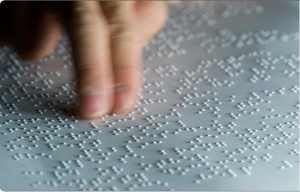 For people who are blind or visually impaired, reading is too often a matter of dependence on other people, either as readers or as translators into Braille. More than 3 million books are published annually in the U.S; only a small percentage of those are also published in Braille.
For people who are blind or visually impaired, reading is too often a matter of dependence on other people, either as readers or as translators into Braille. More than 3 million books are published annually in the U.S; only a small percentage of those are also published in Braille.
Researchers at MIT are tackling the problem with the prototype FingerReader, which would allow anyone to read any printed text. The small device reads text aloud as the user runs her finger along a line of text. Sensors provide feedback to keep the reader on the line and tells him when the line ends.
Other researchers, at MIT’s Computer Science and Artificial Intelligence Laboratory and Microsystems Research Laboratories (MTL), are working on a navigation system for blind people. Also still in prototype, the system uses a low-power chip, a 3-D camera, and a mechanical Braille system developed by CSAIL to give a user information about distance to the nearest obstacle in his path.
“There was some prior work on this type of system,” said Dongsuk Jeon, a postdoc at MTL when the work was done, “but the problem was that the systems were too bulky, because they require tons of different processing. We wanted to miniaturize this system and realized that it is critical to make a very tiny chip that saves power but still provides enough computational power.”